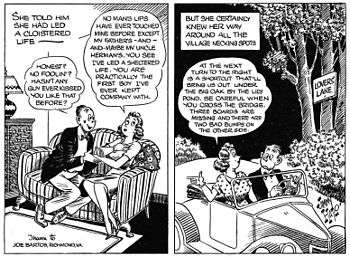Panel (comics)

A panel is an individual frame, or single drawing, in the multiple-panel sequence of a comic strip or comic book. A panel consists of a single drawing depicting a frozen moment.
Newspaper daily strips typically consist of either four panels (Doonesbury, For Better or For Worse) or three panels (Garfield, Dilbert), all of the same size. The horizontal newspaper strip can also employ only a single panel, as sometimes seen in Wiley Miller's Non Sequitur.[1]
In Asia, a vertical four-panel arrangement (yonkoma) is common in newspapers, such as with Azumanga Daioh. In a comic book or graphic novel, the shapes of panels and the number of panels on a page may vary widely.
The word panel may also refer to a cartoon consisting of a single drawing; the usage is a shortened form of "single-panel comic". In contrast to multi-panel strips, which may involve extended dialogue in speech balloons, a typical panel comic has only one spoken line, printed in a caption beneath the panel itself. Many panel comics are syndicated and published daily, on a newspaper page with other syndicated cartoons that are collectively known as comic strips. Major comic strips in panel format include The Far Side, Dennis the Menace, The Family Circus, Ziggy, Herman and Ripley's Believe It or Not. In this context, panels are contrasted with the more common comic strip format, which consists of an actual "strip" of multiple drawings that tell a story in sequence.
Form

There are two major styles used in newspaper comics, single panels and strips. Single panels usually, but not always, are not broken up and lack continuity. The popular Dennis the Menace and The Family Circus are both single panels. Strips on the other hand are generally longer and shaped into a rectangle. Strips include Peanuts and Garfield. J. R. Williams' long-run Out Our Way continued as a daily panel even after it expanded into a Sunday strip, Out Our Way with the Willets. Jimmy Hatlo's They'll Do It Every Time was often displayed in a two-panel format with the first panel showing some deceptive, pretentious, unwitting or scheming human behavior and the second panel revealing the truth of the situation.[2]
Early daily strips were large, often running the entire width of the newspaper, and were sometimes three or more inches high.[3] Initially, a newspaper page included only a single daily strip, usually either at the top or the bottom of the page. By the 1920s, many newspapers had a comics page on which many strips were collected together. Over decades, the size of daily strips became smaller and smaller; until by the year 2000, four standard daily strips could fit in an area once occupied by a single daily strip.[4]
NEA Syndicate experimented briefly with a two-tier daily strip, Star Hawks, but after a few years, Star Hawks dropped down to a single tier.[2]
In Flanders, the two-tier strip is the standard publication style of most daily strips like Spike and Suzy and Nero.[5] They appear Monday through Saturday; until 2003 there were no Sunday papers in Flanders.[6] In the last decades, they have switched from black and white to color.
References
- ↑ Go Comics
- 1 2 Toonopedia
- ↑ Newspaper Archive
- ↑ WebCite: Comic Strip Project
- ↑ Baudart, Sébastien (2005). Strips in de Belgische dagbladpers, 1945–1950 (PDF) (in Dutch). p. 69. Retrieved 2009-05-15.
- ↑ Michielsen, Stefaan (2003-09-26). "Zondagskrant als antwoord van uitgevers op krimpende markt" (in Dutch). De Standaard. Retrieved 2009-05-15.